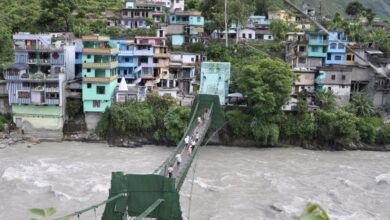Conclave on sustainability in Himalayas conclude

Conclave on sustainability in Himalayas conclude
B.D.Kasniyal
Pithoragarh, Nov 16
A three-day conclave on Himalayan sustainability held comprehensive deliberations on various aspects organised by Gobind Ballabh Pant National Institute of Himalayan Environment (GBPNIHE) concluded at Almora today.
The three-day national conclave on Himalayan sustainability, climate resilience, biodiversity conservation, indigenous knowledge, disaster risk reduction, ecosystem services, green energy and sustainable tourism brought together leading scientists, policymakers, academicians, practitioners, and community experts who deliberated on science–policy–practice linkages essential for safeguarding the fragile Himalayan region.
The second day witnessed intensive technical discussions through parallel sessions. In Parallel Session-V on Environmental Sustainability, Pollution and Waste Management, Prof. S. Ramachandran from PRL highlighted emerging scenarios of climate change and air pollution in the Himalaya, showing how aerosols significantly warm the Himalayan climate and emphasizing the need for long-term atmospheric monitoring. Dr. J.C. Kuniyal of VCSG UUHF discussed waste-to-energy interventions suitable for Himalayan municipalities, focusing on microbial bio-composting, while Dr. Rakshak Kumar of Tripura University presented microbial and glacial bacterial solutions for bioremediation and improved waste management in high altitudes. Together, the speakers stressed strengthening emission standards, integrating advanced measurements, improving waste segregation, and promoting innovative concepts such as polythene recycling into graphene.
In Parallel Session-VI on Biodiversity Conservation and Management, Dr. S.S. Samant of UCOST emphasized the need to bridge gaps among innovation, policy, and local participation to conserve biodiversity threatened by urbanization and biological invasion. Prof. A. Khuroo from the University of Kashmir warned that Himalayan highlands are transitioning from biodiversity hotspots to dark spots due to tourism pressure, advocating nature-based solutions. Dr. Devendra Singh of BSI highlighted the rich bio-diversity of the Himalaya and urged inclusion of bryophytes in environmental impact assessments, while Dr. Hitendra Padalia of IIRS presented AI-driven forest biomass monitoring and advanced remote sensing technologies to map disturbance patterns. The session underscored the need for robust policy frameworks, updated species databases, regulation of exponential tourism, prioritization of sensitive eco-zones such as peatlands, and establishment of long-term monitoring sites.
In Parallel Session-VIII on Indigenous Knowledge and Resilience Building, a panel comprising Dr. R.K. Maikhuri (HNBGU), Dr. Ramesh Chandra (AnSI), Dr. Amba Jamir, Dr. Murugesan (NIRDPR), Dr. M. Ashraf (Ladakh) and Dr. Vikram Veer Bharti (SDSU) deliberated on the dynamic, living nature of Indigenous Knowledge Systems (IKS). Dr. Amba Jamir emphasized that indigenous knowledge continually evolves with ecological understanding, reciprocity, and restraint. Panelists recognized women, pastoralists, and smallholders as key custodians of local wisdom and called for blending traditional knowledge with modern science to enhance climate resilience. Concerns were raised regarding declining agro-biodiversity, erosion of traditional practices, weak intergenerational knowledge transmission, and limited policy inclusion. The panel recommended integrating IKS into policy frameworks, strengthening community-based learning, and revitalizing traditional food, water, and biodiversity practices.
Parallel Session-IX on Disaster Risk Reduction and Natural Hazards featured Dr. Naveen Juyal, who explained how temperature rise in the Higher Himalaya is accelerating cryosphere instability and making GLOF impacts sediment-dominated rather than water-driven. He emphasized that small tributaries and steep gorges are highly hazard-prone and warned against societal complacency in disaster-prone valleys. Prof. Reet Kamal Tiwari highlighted the compound nature of GLOFs influenced by rainfall, landslides, and moraine weakening, stressing the need for catchment-specific early warning systems and integrated modelling of extreme-runout scenarios. The deliberations emphasized strengthening multi-hazard risk assessment, integrating sediment dynamics into planning, creating glacial lake risk indices, restricting development in fragile zones, and establishing a Himalayan Multi-Hazard Operations Cell.
Parallel Session-XI on Wetlands and Peatlands Management included presentations by Dr. Arun Jyoti Nath (Assam University), who highlighted encroachment, pollution, and poor management of Ramsar sites. Ms. Apoorva Thapa from Wetlands International stressed integrated management approaches for Himalayan wetlands. Dr. Dipnarayan Ganguly explained how high-altitude wetlands serve as major carbon sinks with enormous mitigation potential, while Shivani from WISA presented early findings of peatland mapping using machine learning. Speakers urged for integrated wetland management plans, carrying capacity assessment for tourism, peatland mapping, hydrological studies, and regular monitoring of wetlands.
Day three continued with Parallel Session-XIII on Regional Cooperation for Landscape Restoration and Management, where Dr. Rajan Kotru highlighted ecological, economic, and ideological crises in mountain regions, stressing that imagination is more important than knowledge and that India must lead regional policy, carbon credit frameworks, and mountain development cooperation. Dr. G.S. Rawat presented lessons from KSLCDI and emphasized reviving cultural linkages, enhancing scientific collaborations, and strengthening shared management of ecosystem services. Dr. Bandan Shakya outlined transdisciplinary approaches to landscape restoration and noted that current interventions fail to match the scale and speed of ecological change. The speakers collectively called for eastward expansion of the Himalayan mandate, creation of regional funding mechanisms, hydrological dialogue, data sharing frameworks, and establishment of a Himalayan Academy of Sciences.
In Parallel Session-XIV on Ecosystem Services and Finance, Dr. G.C.S. Negi (UCOST) emphasized recognizing Himalaya as natural capital and integrating ecosystem services into GDP calculations. He highlighted the declining dependence of communities on forests and the need for carbon credit and green credit mechanisms. Dr. Swapan Mehera of IORA stressed that ecosystem services from the IHR support billions of downstream residents and highlighted the shrinking forest budgets in Himalayan states. He emphasized nature financing tools such as green bonds, climate insurance, and ecological fiscal transfers. The session concluded on the need for payment for ecosystem services, valuation awareness, pollinator boards, traditional knowledge conservation, and grassroots capacity building.
Parallel Session-XV on Green Energy and Carbon Neutrality included Dr. Sarvesh Kumar (GRIHA), who presented on energy-efficient building codes and the importance of landscape-based green buildings and passive architecture. Dr. M.S. Lodi (NIHE) emphasized mainstreaming passive solar-heated buildings by blending science with traditional practices, noting affordability as key to adoption. Speakers stressed developing region-specific energy solutions such as micro-hydro and PV systems, promoting research on traditional solar-passive buildings, harnessing geothermal and wind energy, establishing technological groups, and scaling green financing.
In Parallel Session-XVI on Sustainable Tourism, chaired by Prof. R.C. Sundriyal and moderated by Er. R.K. Singh, invited speakers Dr. Amit Joshi, Dr. S. Sharma (University of Leh) and Dr. Anu K. Lama (ICIMOD), along with panelists Dr. Swati Sah, Dr. Ashish Tamta, Prof. Rama Maikhuri, Prof. Sundriyal and Dr. V.P. Bhatt, emphasized integrating tourism into climate-resilient policy. They advocated diversifying tourism beyond popular destinations by promoting village-level consortiums, adopting Bhutan’s high-value–low-impact tourism model, forming a Himalayan Tourism Consortium, creating a Himalayan wallet for environmental services, and assessing tourism carrying capacity across destinations.
The plenary and Valedictory session titled Connecting Science–Policy–Practice featured session summaries by Er. R.K. Singh, Dr. Chandra Sekar, Er. M.S. Lodi, Dr. Sandeepan Mukherjee, and Dr. Rajesh Joshi. Director GBPNIHE, Dr. I.D. Bhatt, emphasized the need to integrate recommendations into policy, create accessible databases, establish data-sharing mechanisms and publish research outcomes in dedicated Himalayan journals. Special Guest Dr. Laxmikant (Director, VPKAS) stressed converting recommendations into policy and preventing conversion of agricultural land for industry. Former Secretary to the Government of India, Shri Hem Pandey (IAS), called for regular Pan-Himalayan conclaves, environmentally friendly infrastructure, strong collaboration, and better implementation, remarking that “We need the Himalayas, not the Himalayas.”
Guest of Honour Ms. Nameeta Prasad, Joint Secretary, MoEF&CC, appreciated the collective effort and urged stakeholders to strengthen collaborations, build unified datasets for implementation, and mentor young researchers through interconnected networks. Chief Guest Shri Ajay Verma, Mayor of Almora, emphasized public awareness for protecting the Himalaya and highlighted the responsibility of every citizen towards mountain conservation. The conclave concluded with a vote of thanks by Dr. K. Chandrasekar of GBPNIHE.





